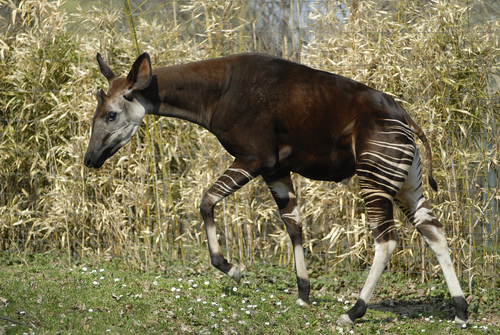
Okapi
The okapi (Okapia johnstoni), with its zebra-striped legs and giraffe-like features, thrives in Congo's rainforests. Solitary by nature, it disperses seeds, supporting forest growth. Its long, prehensile tongue aids in browsing foliage, showcasing a unique blend of traits from two distinct relatives.
200.0 - 300.0 kg
Weight
Length: 1.5 - 2.0 m
Size
Brown, Red, Black, White
Color
2-3 years
Age of Sexual Maturity
6 months
Age of Weaning
37 mph
Top Speed
Endangered
Conservation Status
Decreasing
Population Trend
Characteristics
The okapi, native to the dense rainforests of the Democratic Republic of Congo, is known for its striking zebra-like leg stripes and giraffe-like head and tongue. Solitary and elusive, it plays a crucial role in its ecosystem by dispersing seeds through its fruit-heavy diet.
Distribution Range of the Okapi
The Okapia johnstoni, commonly known as the okapi, is native to the dense rainforests of the Democratic Republic of the Congo (DRC) in Central Africa. It is primarily found in the Ituri Forest, which is located in the northeastern part of the DRC.
Okapi's Habitat
Environmental Conditions
Okapis inhabit tropical rainforest environments characterized by high humidity and relatively stable temperatures ranging from 20°C to 30°C (68°F to 86°F). These areas receive high levels of annual rainfall, averaging between 1,500 to 2,500 millimeters (59 to 98 inches). The dense vegetation provides ample cover and a variety of plant species for the okapi to feed on.
Ecological Niche
The okapi is a herbivorous mammal, primarily a browser, feeding on leaves, buds, grasses, ferns, fruits, and fungi found in the understorey of the rainforest. Its long neck and flexible tongue enable it to reach and strip leaves from branches. The okapi plays a crucial role in its ecosystem by aiding in seed dispersal through its consumption of various fruits. It prefers solitary living, except during mating periods or when a mother is with her calf.
Copyright @ Nature Style Limited. All Rights Reserved.
 English
English